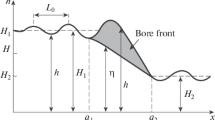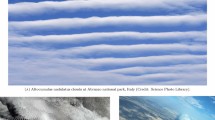Abstract
In this article, consideration is given to weak bores in free-surface flows. The energy loss in the shallow-water theory for an undular bore is thought to be due to upstream oscillations that carry away the energy lost at the front of the bore. Using a higher-order dispersive model equation, this expectation is confirmed through a quantitative study which shows that there is no energy loss if dispersion is accounted for.




Similar content being viewed by others
References
Alazman, A.A., Albert, J.P., Bona, J.L., Chen, M., Wu, J.: Comparison between the BBM equation and a Boussinesq system. Adv. Differ. Equ. 11, 121–166 (2006)
Albert, J.P.: Concentration compactness and the stability of solitary-wave solutions to nonlocal equations. In: Applied Analysis (Baton Rouge, LA, 1996), pp. 1–29. Contemp. Math. vol. 221. American Mathematical Society, Providence (1996)
Ali, A., Kalisch, H.: Energy balance for undular bores. C. R. Mecanique 338, 67–70 (2010)
Ali, A., Kalisch, H.: Mechanical balance laws for Boussinesq models of surface water waves. J. Nonlinear Sci. 22, 371–398 (2012)
Benjamin, T.B., Lighthill, M.J.: On cnoidal waves and bores. Proc. R. Soc. Lond. A 224, 448–460 (1954)
Binnie, A.M., Orkney, J.C.: Experiments on the flow of water from a reservoir through an open channel II. The formation of hydraulic jumps. Proc. R. Soc. Lond. A 230:237–246 (1955).
Bjørkavåg, M., Kalisch, H.: Wave breaking in Boussinesq models for undular bores. Phys. Lett. A 375, 157–1578 (2011)
Bona, J.L., Chen, M., Saut, J.-C.: Boussinesq equations and other systems for small-amplitude long waves in nonlinear dispersive media. I. Derivation and linear theory. J. Nonlinear Sci. 12, 283–318 (2002)
Bona, J.L., Colin, T., Lannes, D.: Long wave approximations for water waves. Arch. Ration. Mech. Anal. 178, 373–410 (2005)
Bona, J.L., Dougalis, V.A., Mitsotakis, D.E.: Numerical solution of KdV-KdV systems of Boussinesq equations. I. The numerical scheme and generalized solitary waves. Math. Comput. Simul. 74, 214–228 (2007)
Bona, J.L., Grujić, Z., Kalisch, H.: A KdV-type Boussinesq system: From the energy level to analytic spaces. Discrete Contin. Dyn. Syst. 26, 1121–1139 (2010)
Bona, J.L., Pritchard, W.G., Scott, L.R.: An evaluation of a model equation for water waves. Phil. Trans. Roy. Soc. Lond. A 302, 457–510 (1981)
Bona, J.L., Varlamov, V.V.: Wave generation by a moving boundary. In: Nonlinear partial differential equations and related analysis, pp. 41–71. Contemp. Math., vol. 371, American Mathematical Society, Providence (2005)
Borluk, H., Kalisch, H.: Particle dynamics in the KdV approximation. Wave Motion 49, 691–709 (2012)
Byatt-Smith, J.G.B.: The effect of laminar viscosity on the solution of the undular bore. J. Fluid Mech. 48, 33–40 (1971)
Chanson, H.: The Hydraulics of Open Channel Flow. Arnold, London (1999)
Chanson, H.: Current knowledge in hydraulic jumps and related phenomena. A survey of experimental results. Eur. J. Mech. B Fluids 28, 191–210 (2009)
Chanson, H.: Undular tidal bores: basic theory and free-surface characteristics. J. Hydraul. Eng. ASCE 136, 940–944 (2010)
Chen, M.: Exact solution of various Boussinesq systems. Appl. Math. Lett. 11, 45–49 (1998)
Constantin, A.: The trajectories of particles in Stokes waves. Invent. Math. 166, 523–535 (2006)
Constantin, A., Strauss, W.: Pressure beneath a Stokes wave. Comm. Pure Appl. Math. 63, 533–557 (2010)
Duruk, N., Erkip, A., Erbay, H.A.: A higher-order Boussinesq equation in locally non-linear theory of one-dimensional non-local elasticity. IMA J. Appl. Math. 74, 97–106 (2009)
Dutykh, D., Dias, F.: Energy of tsunami waves generated by bottom motion. Proc. R. Soc. Lond. A 465, 725–744 (2009)
Ehrnström, M.: On the streamlines and particle paths of gravitational water waves. Nonlinearity 21, 1141–1154 (2008)
Ehrnström, M., Escher, J., Wahlen, E.: Steady water waves with multiple critical layers. SIAM J. Math. Anal. 43, 1436–1456 (2011)
El, G.A., Grimshaw, R.H.J., Smyth, N.F.: Unsteady undular bores in fully nonlinear shallow-water theory. Phys. Fluids 18, 027104 (2006)
Favre, H.: Ondes de Translation. Dunod, Paris (1935)
Fokas, A.S., Pelloni, B.: Boundary value problems for Boussinesq type systems. Math. Phys. Anal. Geom. 8, 59–96 (2005)
Henry, D.: Analyticity of the streamlines for periodic travelling free surface capillary-gravity water waves with vorticity. SIAM J. Math. Anal. 42: 103–3111 (2010)
Kalisch, H.: A uniqueness result for periodic traveling waves in water of finite depth. Nonlinear Anal. 58, 779–785 (2004)
Kalisch, H., Bjørkavåg, M.: Energy budget in a dispersive model for undular bores. Proc. Est. Acad. Sci. 59, 172–181 (2010)
Keulegan, G.H., Patterson, G.W.: Mathematical theory of irrotational translation waves. Nat. Bur. Standards J. Res. 24, 47–101 (1940)
Koch, C., Chanson, H.: Unsteady Turbulence Characteristics in an Undular Bore in River Flow 2006, pp. 79–88. Taylor& Francis Group, London (2006)
Koch, C., Chanson, H.: Turbulence measurements in positive surges and bores. J. Hydraul. Res. 47, 29–40 (2009)
Lemoine, R.: Sur les ondes positives de translation dans les canaux et sur le ressaut ondule de faible amplitude. Jl. La Houille Blanche. 183–185 (1948)
Madsen, P.A., Schäffer, H.A.: Higher-order Boussinesq-type equations for surface gravity waves: derivation and analysis. Phil. Trans. Roy. Soc. Lond. A 356, 3123–3184 (1998)
Peregrine, P.G.: Calculations of the development of an undular bore. J. Fluid Mech. 25, 321–330 (1966)
Rayleigh, Lord: On the Theory of Long Waves and Bores. Proc. R. Soc. Lond. A A90, 324–328 (1914)
Sturtevant, B.: Implications of experiments on the weak undular bore. Phys. Fluids 6, 1052–1055 (1965)
Svendsen, I.A.: Introduction to Nearshore Hydrodynamics. World Scientific, Singapore (2006)
Varlamov, V.: On the initial-boundary value problem for the damped Boussinesq equation. Discrete Contin. Dynam. Syst. 4, 431–444 (1998)
Varlamov, V.: On the spatially two-dimensional Boussinesq equation in a circular domain. Nonlinear Anal. 699–725 (2001)
Wei, G., Kirby, J.T., Grilli, S.T., Subramanya, R.: A fully nonlinear Boussinesq model for surface waves. Part 1. Highly nonlinear unsteady waves. J. Fluid Mech. 294, 71–92 (1995)
Whitham, G.B.: Linear and Nonlinear Waves. McGraw-Hill, New York (1975)
Acknowledgments
This work was supported in part by the Research Council of Norway. The authors would like to thank Professor John Albert for helpful comments.
Author information
Authors and Affiliations
Corresponding author
Additional information
This article is dedicated to the memory of our friend and colleague Vladimir Varlamov.
Appendix A: The numerical scheme
Appendix A: The numerical scheme
The numerical discretization used to find approximate solutions of the system (1.1) is briefly presented. First, it should be noted that mathematical aspects of the system (1.1) have been studied in [9, 11, 28]. In these works, a theory of well posedness for the Cauchy problem and various boundary-value problems has been developed. In [10], a finite-element method for the periodic problem was constructed. Here, we consider a finite-difference method. We begin by writing \(\zeta (x,t) = \eta (x,t) - \eta _0(x)\), and \(\xi (x,t) = w(x,t) - w_0(x)\), so that the functions \(\zeta \) and \(\xi \) satisfy homogeneous Dirichlet boundary conditions. Next, we use the transformation
to obtain a system which is diagonal in the highest derivative. The new variables \(u\) and \(v\) satisfy the equations
The functions \(u\) and \(v\) also satisfy homogeneous Dirichlet boundary conditions at the endpoints \(x_1\) and \(x_2\) of the computational domain. In addition, we require the Neumann conditions \(u_x(x_2,t)=0\) and \(v_x(x_1,t)=0\). The first and third spatial derivatives are approximated by the matrices \(D_{N,1}\) and \(D_{N,3}^u\), \(D_{N,3}^v\), respectively. The matrix \(D_{N,1}\) arises from a standard finite-difference approximation of the first derivative. The matrix \(D_{N,3}^u\) is given by
This matrix arises from the use of one-sided Taylor approximations on the left side of the domain, since only one boundary conditions is required there. Since a Neumann condition is given on the right side of the domain, a simpler pattern is seen in the right lower half of the matrix. Similar considerations are applied to construct \(D_{N,3}^v\).
The system of ordinary differential equations resulting from the spatial discretization is integrated with a combined Crank-Nicholson Adams-Bashforth method. The linear terms are treated with a Crank-Nicholson method, while the nonlinear terms are treated using an Adams-Bashforth method. This combination of time discretizations is explicit, but treats the highest-order spatial derivatives implicitly. Using the notation \(U_N^m\) to denote the \(N\)-vector approximating \(u(\cdot , m \, \delta t)\) at the \(m\)-th time step, and respectively for \(V_N^m\), the equations to be solved at the \(m\)-th time step are
As two previous time steps are required to compute the next time step, the very first time step is done using a simple forward Euler method. The Euler method is locally of second order, and a single time step does not lead to instability problems. In Table 4, a convergence study is presented, using an exact solution found in [19]. In non-dimensional variables, where both \(g=1\) and \(h_0=1\) are set to unity, this solution is given by
for positive \(\kappa \) and \(c\). This exact traveling wave is integrated in time, and it can be seen that second-order convergence is obtained for both the spatial and the temporal discretization. Figure 5 shows both the initial profile \(\eta (x,0)\) and the computed profile \(\eta (x,t)\) at \(t=10\).
Rights and permissions
About this article
Cite this article
Ali, A., Kalisch, H. A dispersive model for undular bores. Anal.Math.Phys. 2, 347–366 (2012). https://doi.org/10.1007/s13324-012-0040-7
Received:
Accepted:
Published:
Issue Date:
DOI: https://doi.org/10.1007/s13324-012-0040-7





